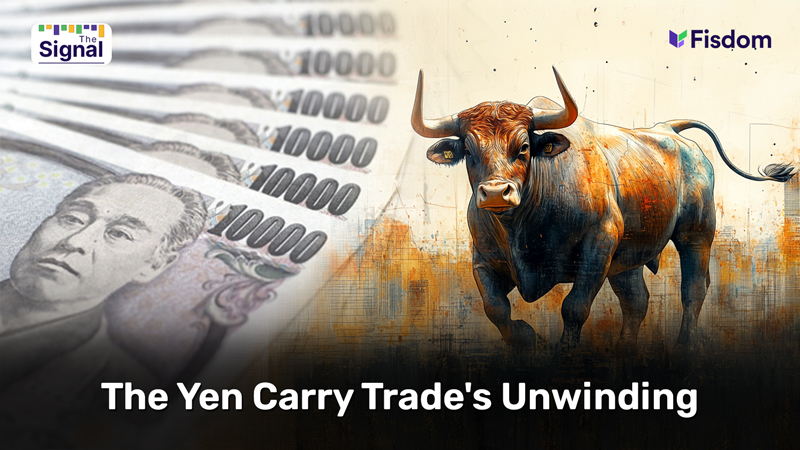
The yen carry trade, a long-standing investment strategy, has recently come under significant scrutiny. This is largely due to the unexpected rate hike by the Bank of Japan (BoJ) at a time when markets were anticipating a rate cut from the U.S. Federal Reserve. This move has led to a sharp appreciation of the yen, resulting in the unravelling of the yen carry trade—a scenario that had been anticipated by a 2019 IMF working paper titled Anatomy of Sudden Yen Appreciations, authored by Fei Han and Niklas J Westelius. This article delves into the nuances of the yen carry trade, its current challenges, and the implications for Indian investors.
The IMF Paper’s on Yen Carry Trade
In their 2019 working paper, Han and Westelius highlighted three primary reasons that could lead to short-term yen appreciation: shifts in monetary policy, rising uncertainty, and the unwinding of carry trades. They noted that a sharp fall in U.S. short-term interest rates or an improved inflation outlook for Japan would likely cause the yen to appreciate sharply against the U.S. dollar—exactly what has transpired.
- Monetary Policy Shifts: The yen exchange rate is sensitive to changes in the perceived interest rate differentials between Japan and other major economies, particularly the U.S. The unexpected rate hike by the BoJ, coupled with the anticipated rate cuts by the U.S. Fed, has led to a narrowing of the yield spread between these two economies, fueling the yen’s appreciation.
- Flight to Safe Havens: In times of global uncertainty, investors tend to flock to safe-haven currencies like the U.S. dollar, Swiss franc, and Japanese yen. With rising global uncertainties, the yen has strengthened, further driven by the BoJ’s policy shift.
- Unwinding of Carry Trades: The yen’s appreciation has triggered the unwinding of carry trades—a strategy where investors borrow in low-interest-rate currencies like the yen to invest in higher-yielding assets abroad. As the yen appreciates, these positions become unprofitable, leading to a rapid reversal and further yen strength.
The Current Unwinding and Its Impact
The BoJ’s unexpected rate hike on July 31st, coupled with the anticipated rate cuts by the U.S. Fed, has dramatically altered the conditions that made the yen carry trade so profitable in recent years. Since 2022, the widening yield spread between Japan and the U.S., coupled with the yen’s depreciation, created a perfect storm for the carry trade to thrive. However, these favourable conditions are now reversing.
With the BoJ signalling further rate hikes and the U.S. Fed expected to cut rates, the yield spread between the two economies is narrowing. This has made the yen carry trade less viable, leading to significant corrections in global markets, including Japan’s Nikkei 225 and India’s Nifty 50.
Key Takeaways for Indian Investors
The unravelling of the yen carry trade has direct implications for Indian equities. As foreign investors unwind their yen carry trade positions, they are pulling funds out of high-yielding markets like India. This has led to a noticeable correction in Indian stock markets, with the Nifty 50 falling by nearly 4% since the BoJ’s announcement.
However, domestic institutional investors (DIIs) have stepped in to provide support, partially offsetting the outflows by foreign institutional investors (FIIs). This has helped to stabilize the market to some extent. Yet, the long-term viability of this support remains uncertain, especially as the yield spread continues to narrow and the yen carry trade becomes increasingly unattractive.
Conclusion
The yen carry trade, once a lucrative strategy, is now facing significant headwinds due to the unexpected policy shifts by the BoJ and the anticipated rate cuts by the U.S. Fed. The resulting market corrections serve as a reminder of the interconnectedness of global financial markets and the importance of monitoring international developments.
For Indian investors, the current market corrections may present opportunities to invest at lower levels, especially given the long-term growth potential of India Inc. However, caution is warranted, as further unwinding of carry trades could lead to additional volatility. As always, a diversified investment approach, combined with a keen eye on global monetary policies, will be crucial in navigating these uncertain times.
In light of the ongoing global market volatility, particularly the unravelling of the yen carry trade, investors need to adopt a more strategic approach to their portfolios. Here’s what investors should consider as they navigate this challenging environment:
- With markets expected to rotate away from low-growth, low-quality segments, it’s crucial for investors to prioritize high-quality stocks. Focus on companies with strong fundamentals, sustainable growth prospects, and a proven track record of delivering consistent returns. These stocks are more likely to weather market turbulence and provide steady returns over the long term.
- Large-cap stocks should be at the core of your investment strategy. These companies tend to offer more stability and resilience, especially during periods of heightened market volatility. Their established market positions and robust financials make them a safer bet in uncertain times.
- While large caps should dominate your portfolio, don’t completely overlook opportunities within midcaps and small caps. Look for companies in these segments that have solid fundamentals, strong growth prospects, and experienced management teams. These stocks can offer significant upside potential, but selective exposure is key to managing risk.
- Keep a close eye on global developments, as events like the unwinding of the yen carry trade, U.S. recession fears, and geopolitical tensions in the Middle East could continue to fuel market volatility. Being informed will allow you to make timely adjustments to your portfolio, mitigating potential risks.
- Given the potential underperformance of certain sectors and ongoing global market fluctuations, now is an opportune time to reassess and rebalance your portfolio. Emphasize quality and growth-oriented investments, ensuring your holdings are well-positioned to capitalize on long-term opportunities while safeguarding against downside risks.
- Adopt a Long-Term Perspective: Despite the short-term volatility, maintaining a long-term investment approach focused on quality and growth is likely to yield better results. Stay invested in fundamentally strong companies that are well-positioned to endure market uncertainties and deliver sustainable growth. Regularly review and adjust your portfolio in response to global trends, ensuring it remains aligned with your long-term financial goals.
Market this week
| 05th August 2024 (Open) | 09th August 2024 (Close) | %Change | |
| Nifty 50 | ₹ 24,303 | ₹ 24,365 | 0.3% |
| Sensex | ₹ 78,588 | ₹ 79,706 | 1.4% |
- The market extended its decline for the second consecutive week ending August 9, driven by high volatility due to US recession fears, unwinding of the yen carry trade, geopolitical tensions in the Middle East, a neutral RBI policy outcome, and mixed earnings from Indian companies.
- On the sectoral front, the Nifty Metal and PSU Bank indices dropped nearly 3%, the Nifty Energy index declined 2.5%, and both the Nifty Bank and IT indices fell 1.5% each.
- In contrast, the Nifty Pharma index gained 1.5%, while the Nifty Healthcare and FMCG indices rose 0.5% each.
- Foreign institutional investors (FIIs) sold equities worth ₹19,139.76 crore, while Domestic Institutional Investors (DIIs) purchased equities worth ₹20,871.10 crore.
Weekly Leaderboard
| NSE Top Gainers | NSE Top Losers | ||||
| Stock | Change (%) | Stock | Change (%) | ||
| Cipla | ▲ | 3.0 % | Grasim Industries | ▼ | (5.0) % |
| Eicher Motors | ▲ | 2.2 % | TATA Steel | ▼ | (4.0) % |
| HUL | ▲ | 2.0 % | Ultra Tech Cement | ▼ | (4.0) % |
| Bajaj Auto | ▲ | 1.6 % | Maruti Suzuki | ▼ | (4.0) % |
| ITC | ▲ | 1.4 % | Bharat Petroleum | ▼ | (4.0) % |
Stocks that made the news this week:
- Lupin surged over 3 percent to reach a 52-week high on August 9 after JPMorgan upgraded its rating on the stock to ‘overweight’ following the company’s strong Q1FY25 results. The global brokerage also increased its price target to Rs 2,400, predicting an additional 17 percent upside despite Lupin’s impressive 90 percent returns over the past year, stating that the company still has significant growth potential.
- Suzlon Energy’s market capitalisation crossed the Rs 1 lakh crore mark for the first time on August 9, as the stock rose over three percent to hit a fresh 52-week high. This achievement makes Suzlon the 99th company in India to reach this milestone. The surge follows Suzlon’s announcement of acquiring a 76 percent stake in Renom Energy Services from the Sanjay Ghodawat Group.
- Godfrey Phillips shares surged over 5 percent after the company reported strong earnings for the June 2024 quarter. The cigarette maker posted a net profit of Rs 273 crore, excluding an exceptional loss of Rs 44.6 crore related to its retail business closure. The company also recorded a 22 percent increase in consolidated gross sales to Rs 3,186 crore, with a gross profit margin of 16.9 percent.














